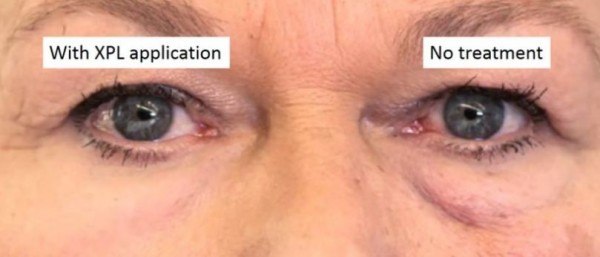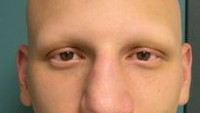Scientists Develop a 'Second Skin' that Makes Skin Youthful Looking
| Arthur Dominic Villasanta | | May 10, 2016 08:00 AM EDT |
(Photo : Olivio Labs / MIT) A test subject receives the treatment on the right side of her face, while the right remains unchanged.
The search for beauty now becomes a matter of wearing a "second skin." Just spread a special and invisible cream on your skin and watch the wrinkles on your skin fade away - at least temporarily.
Researchers at MIT have developed a new material (much like a "fountain of youth" for the skin) you spread on like a cream.
Like Us on Facebook
They said this new product that goes by the unsexy name "XPL" is a breatheable, silicone-based polymer that can tighten the skin; smooth wrinkled skin and conceal eye bags, among many other benefits.
With more research, this material can also be used to deliver drugs to help treat skin conditions such as eczema and other types of dermatitis.
"What we've been able to do is create a cream basically that you can put on the skin," said Robert Langer, a professor at MIT. "And then once it's on the skin, it can actually form essentially an elastic second skin."
XPL, which was tested on 170 subjects in a pilot study, can be applied on the skin as a thin, imperceptible coating. Researchers said the material mimics the mechanical and elastic properties of healthy, youthful skin.
Tested on human subjects, XPL was able to reshape eye bags under the lower eyelids. This second skin can also be adapted to provide long-lasting ultraviolet protection.
"It's an invisible layer that can provide a barrier, provide cosmetic improvement, and potentially deliver a drug locally to the area that's being treated. Those three things together could really make it ideal for use in humans," said Daniel Anderson, an associate professor at MIT's Department of Chemical Engineering.
XPL is delivered in a two-step process. First, polysiloxane components are applied to the skin, followed by a platinum catalyst that induces the polymer to form a film that remains on the skin for up to 24 hours.
This catalyst has to be added after the polymer is applied because the material becomes too stiff to spread after this step. Both layers are applied as creams or ointments. Once spread onto the skin, XPL becomes invisible.
Researchers performed several studies in humans to test the material's safety and effectiveness. In one study, XPL was applied to the under-eye area where eye bags often form as skin ages. Eye bags are caused by protrusion of the fat pad underlying the skin of the lower lid.
When the material was applied, it applied a steady compressive force that tightened the skin, an effect that lasted for some 24 hours. The material is also immune to water and soap.
"Creating a material that behaves like skin is very difficult," said Barbara Gilchrest, a dermatologist at MGH. "Many people have tried to do this, and the materials that have been available up until this have not had the properties of being flexible, comfortable, nonirritating, and able to conform to the movement of the skin and return to its original shape."
Some 10 years ago, the research team set out to develop a protective coating that could restore the properties of healthy skin for both medical and cosmetic applications. A paper describing the polymer was published in the May 9 online issue of Nature Materials.
Researchers at MIT, Massachusetts General Hospital (MGH), Living Proof and Olivo Labs partnered to develop the cream.
You can watch a video about XPL here.
TagsXPL, second skin, MIT, eye bags
©2015 Chinatopix All rights reserved. Do not reproduce without permission
EDITOR'S PICKS
-

Did the Trump administration just announce plans for a trade war with ‘hostile’ China and Russia?
-

US Senate passes Taiwan travel bill slammed by China
-

As Yan Sihong’s family grieves, here are other Chinese students who went missing abroad. Some have never been found
-

Beijing blasts Western critics who ‘smear China’ with the term sharp power
-

China Envoy Seeks to Defuse Tensions With U.S. as a Trade War Brews
-

Singapore's Deputy PM Provides Bitcoin Vote of Confidence Amid China's Blanket Bans
-

China warns investors over risks in overseas virtual currency trading
-

Chinese government most trustworthy: survey
-

Kashima Antlers On Course For Back-To-Back Titles
MOST POPULAR
LATEST NEWS
Zhou Yongkang: China's Former Security Chief Sentenced to Life in Prison

China's former Chief of the Ministry of Public Security, Zhou Yongkang, has been given a life sentence after he was found guilty of abusing his office, bribery and deliberately ... Full Article
TRENDING STORY

China Pork Prices Expected to Stabilize As The Supplies Recover

Elephone P9000 Smartphone is now on Sale on Amazon India

There's a Big Chance Cliffhangers Won't Still Be Resolved When Grey's Anatomy Season 13 Returns

Supreme Court Ruled on Samsung vs Apple Dispute for Patent Infringement

Microsoft Surface Pro 5 Rumors and Release Date: What is the Latest?












